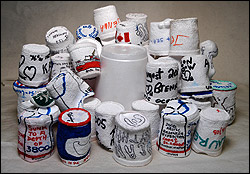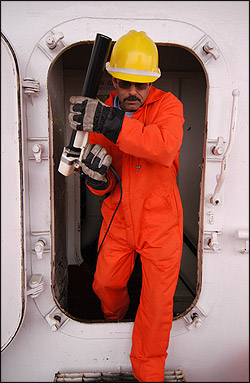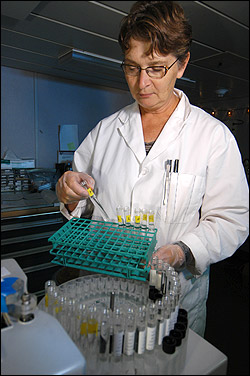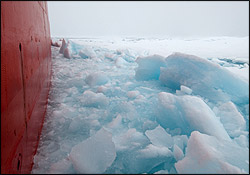Please note: You are viewing
the unstyled version of this website. Either your browser does not support CSS
(cascading style sheets) or it has been disabled. Skip
navigation.
Chris LinderAugust 13, 2005
This afternoon I stopped by Linda White's lab to talk to her about her work on the Louis. Linda is analyzing water samples from the rosette for their nutrient concentrations. "Think of the ocean like a big garden" she tells me. "And nutrients are the fertilizer--except instead of your common home garden fertilizers such nitrogen, phosphate, and potassium, in the ocean we have silicate, phosphate, and nitrate. The levels of nutrients in the water column can tell us where that water originated. For example, water that has come from the Pacific has distinctively high nutrient levels compared to water from the Atlantic. Nutrient analysis is another one of the tools we are using to study circulation in the Arctic." In honor of the weekend, we enjoyed a little break from the shipboard routine tonight. Chief Cook Paul Devlin fried up some spicy chicken wings for "Wing Night" in the ship's lounge. It was an opportunity to relax and unwind after the long hard hours both ship's crew and science party have been putting in on this expedition. Yet, while some of us were in the lounge others were sleeping in anticipation of their night watch. CTD and XCTD science stations continue through the night as we power our way north to the site of Beaufort Gyre Observing System Mooring B. We hope to be on station and ready to pop the mooring release right after breakfast. Then the search is on to find a floe big and strong enough to make a home for our first ice-tethered profiler buoy. Last updated: October 7, 2019 | ||||||||||||||||||||||
Copyright ©2007 Woods Hole Oceanographic Institution, All Rights Reserved, Privacy Policy. | ||||||||||||||||||||||






